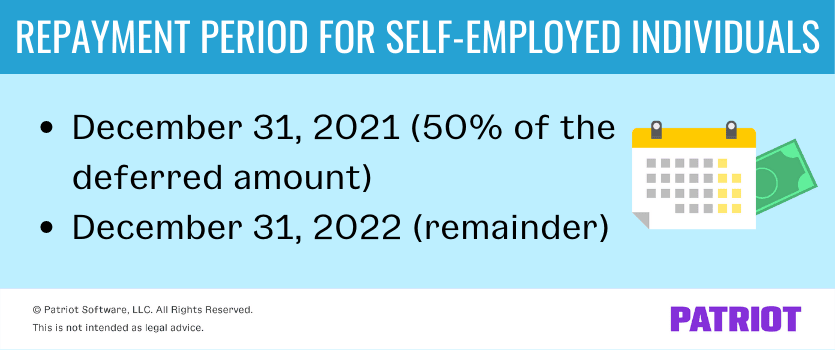In 2020, COVID-19 took the world by storm. To provide relief during the pandemic, the IRS allowed eligible employees and self-employed individuals to defer Social Security tax temporarily. And now, it’s time for individuals (or their employers) to collect and pay back the deferred tax. But, how does the self-employed Social Security tax deferral work? Let us break it down for you.
Social Security tax deferral overview
The CARES Act allowed employers, including self-employed individuals, to defer a portion of Social Security (SS) tax temporarily.
An executive order and the Consolidated Appropriations Act also established an employee SS tax deferral and extended the deferral repayment deadline for the employee portion. However, the employee deferral has a shorter repayment period than the employer/self-employed deferral under the CARES Act.
For both the employer and employee Social Security tax deferrals, the deferral period is over. If you deferred any employer or employee SS taxes, you must begin repaying them now.
Social Security tax deferral and self-employed individuals
Thanks to passed legislation, self-employed individuals were allowed to defer 50% of their Social Security tax portion of self-employment tax from March 27, 2020 – December 31, 2020. This means self-employed workers could defer 6.2% in Social Security tax of their taxable income (50% of their 12.4% Social Security tax responsibility) during the deferment period.
Self-employed individuals could not defer their Medicare portion of self-employment taxes. Just half of the Social Security tax portion using Form 1040, U.S. Individual Income Tax Return.
Again, self-employed individuals have a longer repayment period for the Social Security tax deferral. For taxes deferred in 2020, the repayment period for self-employed individuals (and employers) is:
- December 31, 2021 (50% of the deferred amount)
- December 31, 2022 (remainder)
If a self-employed individual chose to only defer part of their maximum deferral amount, any excess of 50% of the maximum deferral amount is due in 2021. The remaining 50% is due in 2022. For example, if you were eligible to defer $6,000 and only deferred $4,000, you only need to pay the excess $1,000 in 2021 and the remaining $3,000 in 2022 ($6,000 / 2).
Self-employed Social Security tax deferral example
Say your taxable income is $50,000 per year. In 2020, you took advantage of the SS tax deferral. As a reminder, the self-employed deferral is 50% of the Social Security portion of self-employment taxes, or 6.2%. Here’s how much you deferred in 2020:
$50,000 X 0.062 = $3,100
You were eligible for and deferred a total of $3,100 in Social Security taxes during the year. You must repay $1,550 by December 31, 2021, and repay the remaining $1,550 by December 31, 2022.

How to repay self-employed Social Security tax deferral
Individuals can pay back their deferred portion of Social Security tax on or before the due dates.
To repay the deferred taxes, self-employed individuals can make payments:
- Through the Electronic Federal Tax Payment System (EFTPS)
- By credit or debit card
- With a money order or a check
Individuals should also:
- Make sure the payments are separate from other tax payments to ensure they are applied to their deferred balance
- Designate the payment as “deferred Social Security tax”
If you pay via EFTPS, select “1040 US Individual Income Tax Returns” and “deferred Social Security tax” for the type of payment. Apply the payment to the 2020 tax year when repaying.
For the IRS’s Direct Pay option (paying via bank account), select the reason for the payment as “balance due.”
If you use the Card Program to pay via debit or credit card, select “installment agreement” and apply the payment to the 2020 tax year.
For more information about Social Security tax deferral repayment options, check out the IRS’s website.
Want to impress your friends at a dinner party?
Get the latest accounting news delivered straight to your inbox.
Subscribe to Email ListOther must-know self-employed deferral of Social Security tax questions
Have more questions about the self-employed SS tax deferral and repayment? We have answers.
Can self-employed individuals defer 2021 taxes, too?
No, individuals were only able to defer taxes in 2020. The repayment period for self-employed individuals is in 2021 and 2022.
Can individuals pay more than the 50% repayment amount?
Yes, individuals can opt to may more than the 50% by the 2021 deadline. If you decide to pay more than 50%, you must still pay the remaining balance by December 31, 2022.
What should self-employed individuals do if they can’t pay by the due date?
Self-employed individuals who are unable to pay the full deferred tax amount back should pay whatever they can afford by the installment due dates.
If the amount is not paid in full, the IRS will send the taxpayer a balance due notice. If you receive a notice, follow the instructions to make a payment and apply for a payment plan.
For more information about payment options, check out the IRS’s Paying Your Taxes page.
Where can you find more information on the self-employed Social Security tax deferral requirements?
To learn more information about self-employed Social Security tax deferral rules, check out the IRS’s website or contact the IRS directly.
This is not intended as legal advice; for more information, please click here.



